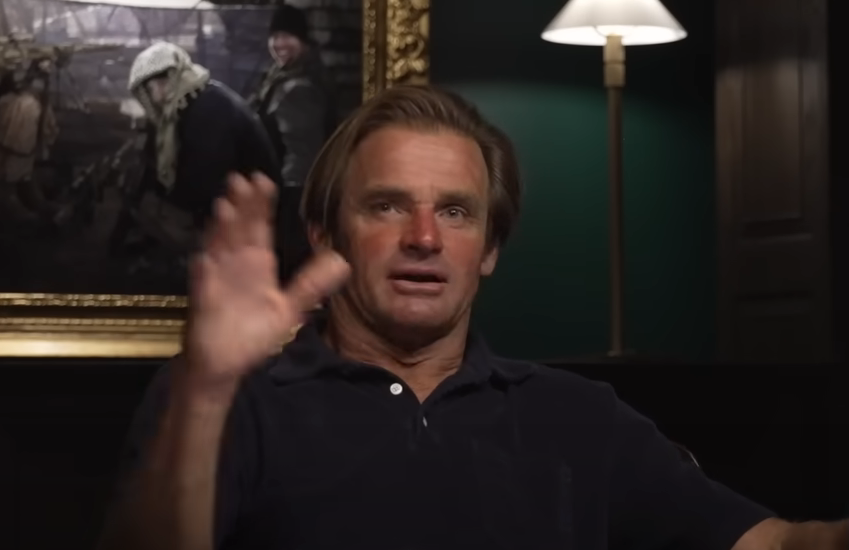In the world of professional surfing, few names are as synonymous with big wave riding as Laird Hamilton. Known for his fearless approach and innovative techniques, Hamilton has carved out a legacy as one of the most influential surfers of all time. Yet, beneath the surface of his success lies a personal battle that has shaped his life in profound ways: his journey to sobriety.
The Alcoholic’s Wave
In a recent interview on the Shawn Ryan Podcast Laird broke down the impact Alcohol had on him. “Alcoholics like surfing; everybody’s a surfer, and everybody’s an alcoholic,” Hamilton said in a candid podcast interview. “We’re all naturally alcoholics and surfers.” This statement encapsulates the dual nature of addiction and passion that many surfers experience. For Hamilton, surfing and alcoholism were intertwined, each feeding off the other in a cycle of highs and lows.
Reflecting on his struggles, Hamilton shared, “I’m not good with alcohol. I think I can jump over the building, and nothing ever good came out of anything drinking.” His candidness about the negative impacts of alcohol—impairing judgment and leading to poor decisions—resonates with many who have faced similar battles. “All the worst things I’ve ever done…it says it right on the bottle: impairs judgment and motor skills.”
Turning Point
Hamilton’s journey to sobriety wasn’t catalyzed by a single dramatic event but rather a series of realizations and experiences. “There was a culmination of a bunch of incidences—behavior, relationship stuff, health, whatever,” he recalled. The potential threat to his relationship with his wife, Gabby Reece, and the desire to set a better example for his children were significant motivators. “It was contributing to hurting my relationship with Gabby, who I love, and it was starting to expose the girls to it.”
A key moment in his decision to quit drinking was an incident involving a car accident. “I think I banged a pole and didn’t set the airbags, but sheared the pole off,” he admitted. This near-miss served as a wake-up call, highlighting the dangerous path he was on.
The Discipline of Sobriety
Hamilton’s approach to sobriety was rooted in discipline. “I didn’t have AA, I didn’t have any reinforcement, no help, no nothing. Just cold turkey, boom, start, done, finished.” His determination and self-reliance are evident in his story. “I have no desire, no interest, and what I really came to learn about it was that it really was a sugar addiction.”
This insight into the link between sugar and alcohol addiction adds a unique dimension to Hamilton’s narrative. “It’s a sugar addiction; it’s the highest level. When you look at alcohol and you think about it, liquid sugar, it just goes right into your bloodstream.” This realization helped him understand the deeper roots of his cravings and provided a new perspective on managing his addiction.
‘It’s a sugar addiction; it’s the highest level. When you look at alcohol and you think about it, liquid sugar, it just goes right into your bloodstream.’
Laird Hamilton on his potential sugar addiction.
The Larger Picture: Addiction in Surfing
Hamilton’s story is not unique in the surfing world. The culture of surfing, with its emphasis on freedom and pushing limits, has historically been linked with substance abuse. Many surfers have struggled with addiction, sometimes with tragic outcomes.
One of the most notable cases is that of Andy Irons, a three-time world champion whose life was cut short at 32 due to a drug overdose. Irons’ struggles with bipolar disorder and substance abuse were well-documented, and his death sent shockwaves through the surfing community. His story is a sobering reminder of the perils that come with the highs of professional surfing.
Tom Carroll, another legendary surfer, has also been open about his battles with cocaine and methamphetamine addiction. Carroll’s journey to sobriety involved a combination of therapy, family support, and a renewed focus on his health and career. His candid discussions about his experiences have helped raise awareness about addiction in the surfing world.
Moving Forward
Hamilton’s story of overcoming addiction through sheer willpower and self-discipline is inspiring. It highlights the importance of self-awareness and the willingness to confront one’s demons. His journey also underscores the need for greater support and resources for athletes struggling with addiction. In a previous interview he has touched on potential mental health struggles that may have contributed to his addictions but refused to use them as the cause.
As Hamilton continues to ride the waves, both literal and metaphorical, his story serves as a beacon of hope for others facing similar challenges. His message is clear: it’s never too late to take control of your life and steer it in a positive direction.
In Hamilton’s words, “If you can’t be true to yourself, you can’t be true to anyone else.” This philosophy has guided him through his darkest moments and continues to shape his path forward, both in the water and in life.
